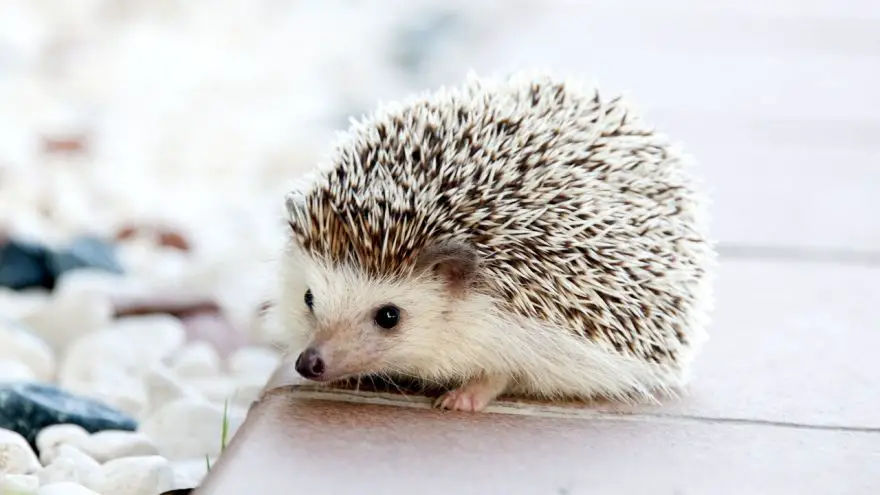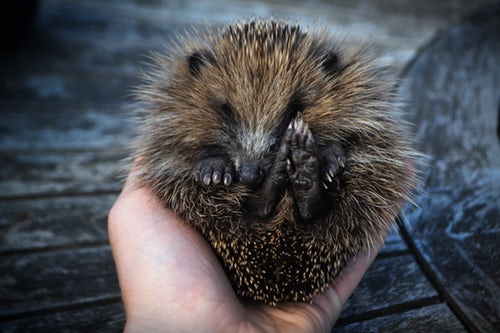Hedgehog Care for Beginners: What You Need to Know
 Hedgehog Care for Beginners: What You Need to Know
thegearhunt.com
Hedgehog Care for Beginners: What You Need to Know
thegearhunt.com
Hedgehogs are adorable little animals that eat insects. On average, they live to about 7 years when people keep them as pets. They are known as timid creatures, but any hedgehog owner can tell you that not only will they respond to the appearance and voice of their owner, if they are properly socialized they can be quite interactive.
In the right circumstances, they can make amazing pets, but that doesn’t mean that they will be a good option for everyone. Before you run out to get a hedgehog, you will need to learn about them as much as possible to ensure that this is the creature that will be ideal for you.
Where They Live
Hedgehogs in the wild are native to New Zealand, Europe, Asia, and Africa. While they aren’t native to North America, they have become quite popular here as pets. Most of the pet hedgehogs in this continent were bred from species native to Africa and are considered to be domesticated. Typically, they are called African Pygmy hedgehogs. With the right environment and cage setup they can thrive while in captivity and be social, fun pets.
Where You Can Get One
Should you adopt a hedgehog or buy one? The IHA, International Hedgehog Association, and the HWS, Hedgehog Welfare Society, are both great resources when it comes to finding hedgehogs to adopt. Just as with other types of animals, they can also be found in shelters all over the country. Additionally, there are quite a few pet stores and breeders who are reputable and sell hedgehogs.
If you want to prevent medical issues from occurring, all hedgehogs need to have a checkup with a vet who has experience with the species as soon as you adopt or purchase them. They should also have annual examinations for the rest of their lives. Hedgehogs aren’t animals that require vaccinations, but they do need things like having their stool checked once a year for parasites and having their nails trimmed as needed.
Who Should Have Hedgehogs?
 Hedgehogs are like porcupines in that the skin over their back is covered with little quills that are quite prickly and that help to keep it protected from predators. That being said, the animals differ in that while a porcupine can shoot these quills out if necessary for defense, the hedgehog can’t. Because of these quills, they can be trying to hold, which means that this animal might not be the best choice for families that have younger children or members who have skin that is quite sensitive. Until the animal relaxes, it is best to hold them in a towel.
Hedgehogs are like porcupines in that the skin over their back is covered with little quills that are quite prickly and that help to keep it protected from predators. That being said, the animals differ in that while a porcupine can shoot these quills out if necessary for defense, the hedgehog can’t. Because of these quills, they can be trying to hold, which means that this animal might not be the best choice for families that have younger children or members who have skin that is quite sensitive. Until the animal relaxes, it is best to hold them in a towel.
A hedgehog can be fantastic for people who have a lot of time during the day that they can use to socialize with it. They also do well when they are housed by themselves and don’t necessarily need to be housed with other hedgehogs, but you will need to let them come out of their cages at least one time a day for both social interaction and exercise.
Hedgehogs are known for being shy and will use their very strong back muscles to roll into a tight ball. This serves to hide their face while it also points their quills outward so that any predators won’t be able to see their limbs and/or faces. They will hold their ball position until they are no longer feeling threatened or frightened. In order to minimize this response to fear, owners of hedgehogs should begin taking them out of their cage once a day while they are still quite young so that they will get used to people and to being handled so they won’t ball up on you.
Hedgehogs are creatures that are nocturnal, so they will be best for those who sleep during the day and who won’t be disturbed by the exercise wheel running all night long. They might sleep for quite a few hours each day, which makes them ideal for those who want to play with or interact with them during the evenings.
Caring for Them
If you are going to have a hedgehog, you will also need to have a cage that they won’t be able to escape from. This cage should be a large one, like the wire enclosures that are made for guinea pigs. The floor of the cage needs to be solid though – not made from wire. This is due to the fact that the animal’s feet can get caught in the wire. You will need to line their cage with either newspaper or some other sort of bedding that is paper-based. Cat litter and wood shavings aren’t recommended because they can be quite dusty. Also, if your hedgehog eats some, it is not digestible, and this can lead to a gastrointestinal obstruction. You can train your hedgehog to use a small litter box, and this should also be lined with litter that is paper-based. Just put it in the corner of their cage.
You will also need to get a heavy bowl that the animal can’t tip over for their pelleted food, and a smaller bowl for the insects they also need. Sometimes, you can train them to drink water from a bottle that you can fasten to their cage, but most of them prefer to drink from a bowl.
All hedgehogs need to be given a wheel that has smooth sides – not one made from wire – to run in, and a place to hide, such as a plastic rodent igloo that you can find in a pet store or a wooden box with a hole cut in it for a door.
Hedgehog cages need to be spot cleaned every day in order to make sure that they are kept free of fecal contamination as well as leftover debris from food. They need to be given a thorough cleaning on a weekly basis by taking out all of the bedding and changing it out for fresh bedding. Fresh water and food should be given on a daily basis.
Hedgehogs are known for the tendency to grow obese, so exercise on a daily basis is essential. You should also provide them with some sort of mental stimulations for when they are in their cage. This could be anything like toys such as certain chew toys that are meant for cats, bells, balls, cage furniture or PVC pipe to climb through and on, tunnels, ledges, and ramps to keep them busy.
What They Eat
 Hedgehogs eat insects, but that isn’t the only thing they eat. Hedgehogs in the wild will eat different things that can include things like melons, berries, roots, mushrooms, carrion, fish, eggs, snakes, lizards, amphibians, and mollusks.
Hedgehogs eat insects, but that isn’t the only thing they eat. Hedgehogs in the wild will eat different things that can include things like melons, berries, roots, mushrooms, carrion, fish, eggs, snakes, lizards, amphibians, and mollusks.
Pet domesticated hedgehogs need to be fed pelleted formulas that have been specifically manufactured for hedgehogs. This needs to be supplemented with insects such as waxworms, earthworms, crickets, or mealworms. They also need a few things like carrots, apples, corn, beans, and peas.
Because of their love for catching wild prey, you shouldn’t give them too many live insects so that they won’t choose them over other types of foods. This can lead to their diet becoming unbalanced, and they will quickly become overweight.
Potential Health Issues
This animal can suffer from quite a few different medical issues. Some of the ones that are the most common include things like mites and skin infections with fungus – such as ringworm. Both mites and ringworm can cause their skin to become crusty, flaky, and dry and can also lead to a loss of quills. When hedgehogs are babies, they will lose their quills and then replace them as they grow. Adults can also periodically lose their quills. However, with the mites and ringworm, the quills will disappear in patches to expose areas where there is dry skin.
Ringworm can be transferred to people, while the mites, as species specific critters, cannot. Both of these conditions are easily treated with medication that can be prescribed by your vet.
Hedgehogs can also develop issues with their teeth. These can include things like the formation of abscesses, gum infection, gingivitis, and the buildup of tartar. Signs of these issues can include a decreased appetite, dental pain, and excess salivation. If these dental issues are severe, they will need things like possible antibiotics, removal of any abscesses, and/or dental cleaning.
 Another huge issue with hedgehogs is obesity (pun not intended). Hedgehogs that are obese can have fat little legs and a large amount of subcutaneous fat. This will stick out from under the quill part of the body (known as the mantel) as well as in their armpits. Hedgehogs that are obese might not be able to ball up as they should and can even develop brittle bones from a deficiency of calcium. This is a particular problem if they eat a lot of insects. Hedgehogs that are overweight should be given restricted amounts of their food while also being encouraged to run either on their wheel inside the cage or outside of the cage in your home.
Another huge issue with hedgehogs is obesity (pun not intended). Hedgehogs that are obese can have fat little legs and a large amount of subcutaneous fat. This will stick out from under the quill part of the body (known as the mantel) as well as in their armpits. Hedgehogs that are obese might not be able to ball up as they should and can even develop brittle bones from a deficiency of calcium. This is a particular problem if they eat a lot of insects. Hedgehogs that are overweight should be given restricted amounts of their food while also being encouraged to run either on their wheel inside the cage or outside of the cage in your home.
Hedgehogs that are older can also develop heart disease that is manifested by weakness. Additionally, things like heart failure, heart murmurs, weight loss, difficulty breathing, and even death can occur. When these things are diagnosed early, they can be medically managed in order to both prolong their life and improve their overall quality of life.
Another issue that hedgehogs might deal with is salmonella or other types of bacteria. This animal is able to carry this type of bacteria right in their gastrointestinal tracts without even showing any sort of signs. Alternatively, they might have signs like lethargy, decreased appetite, weight loss, and diarrhea. Because this bacterium is transferable to people, it is always critical that anyone who handles a hedgehog or their cage to be sure to thoroughly wash their hands immediately afterward.
Another medical issue that is commonly encountered with this animal is something called wobbly hedgehog syndrome. This is a neurological disease and we don’t know what causes it. It leads to nerve damage as well as a progressive type of paralysis that typically starts in the hedgehog’s hind end and works its way up to the front end.
 Typically, when the hedgehog begins to be affected, they will wobble a bit when they walk and will eventually lose their ability to form a ball. These symptoms will progress as the months pass until they develop seizures, tremors, falling over, and the inability to stand. There isn’t an effective test or treatment for this condition and it tends to kill the animal within a couple of years.
Typically, when the hedgehog begins to be affected, they will wobble a bit when they walk and will eventually lose their ability to form a ball. These symptoms will progress as the months pass until they develop seizures, tremors, falling over, and the inability to stand. There isn’t an effective test or treatment for this condition and it tends to kill the animal within a couple of years.
Just as with other animals, hedgehogs can also develop tumors. The most common type is called squamous cell carcinoma and it affects their mouth. This leads to things like oral pain, tooth loss, and swollen gums. Treatment for this issue involves the tumor being surgically removed, along with other types of therapies, like radiation. Because this species is prone to developing more tumors as they get older, it is critical that they are regularly checked by a vet.
When they are well socialized and properly cared for, hedgehogs make fantastic pets.
Fun Facts
The average lifespan of a hedgehog is about 7 years, but some have lived to be as old as 9 years.
They don’t like direct sunlight, but they thrive in temps ranging from 65 – 80F.
Hedgehogs were used before groundhogs when it came to the prediction of spring.
In some countries, this species is still consumed as food or used for rituals or medical purposes.
Baby hedgehogs will spend most of the time sleeping.
Oddities and Concerns
 Unless you are trying to breed them, keep female and male hedgehogs separated. Females and males become ready to breed at different times, so if you want to breed them, check the timing of each of their mating schedules.
Unless you are trying to breed them, keep female and male hedgehogs separated. Females and males become ready to breed at different times, so if you want to breed them, check the timing of each of their mating schedules.
Having too many hedgehogs in one place or housing more than 1 in a cage can result in the loss of eyes because they can be poked out by their quills.
Lesions and cancers are a possibility. Their risk is just as high as any other species.
This creature will froth at their mouth and then tilt their head upwards in order to coat their quills with saliva. We don’t know why they do this.
There are quite a few online resources where you will be able to get more information. But, above all else, just have fun with your new pet.















